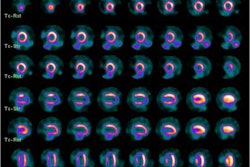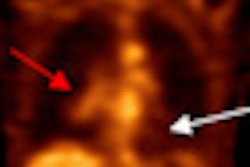A nuclear medicine protocol with two radiopharmaceuticals can identify high-risk patients with potentially life-threatening cardiovascular conditions and help physicians determine which patients are best suited for implantable cardioverter defibrillator (ICD) therapy, according to a study in the August issue of the Journal of Nuclear Medicine.
Researchers from Japan also concluded that with the protocol, physicians can pinpoint the precise location of cardiovascular disease and eliminate the need for invasive medical devices and unnecessary surgical techniques. The lead author of the study was Kimio Nishisato, MD, from the cardiology division of Muroram City General Hospital in Muroram (JNM, August 2010, Vol. 51:8, pp. 1241-1249).
The group hypothesized that both the impairment of myocardial perfusion and/or cell viability and cardiac sympathetic innervations are responsible for heart arrhythmia and sudden cardiac death. However, there has been no established method of detection that is objective, reproducible, and quantitative, they wrote.
The researchers investigated prognostic implications of cardiac presynaptic sympathetic function quantified by a protocol that combined planar imaging with an iodine-123 metaiodobenzylguanidine (MIBG) radiopharmaceutical and SPECT myocardial perfusion imaging with technetium-99m tetrofosmin.
The study enrolled 60 consecutive patients with a mean age of 53 years who had undergone ICD treatment. All patients underwent both cardiac MIBG and tetrofosmin myocardial perfusion imaging within two weeks of ICD implementation.
After discharge, all patients were followed by cardiologists at least every three months at an outpatient pacemaker clinic. During the follow-up period, ICD discharges were documented in 30 patients (50%); three cardiac deaths due to congestive heart failure were observed in this group.
Patients with lethal events had significantly reduced cardiac MIBG activities, compared with patients with no lethal events.
Based on these results, the study showed the efficacies of the method for more accurately identifying patients at greater risk of lethal arrhythmias and sudden cardiac death.
The authors noted that more precise strategies, such as the molecular imaging technique used in this study, are needed to identify patients at high risk for sudden cardiac death who are most likely to benefit from ICD therapy.
By Wayne Forrest
AuntMinnie.com staff writer
August 23, 2010
Related Reading
Gated SPECT best indicator for cardiac events, April 13, 2009
ACC study: Most cardiac SPECT scans are appropriate, April 1, 2009
MRI, MDCT err in estimating cardiac functional parameters, February 20, 2009
PET, SPECT measures of LVEF have superior predictive value, March 13, 2006
Copyright © 2010 AuntMinnie.com




















